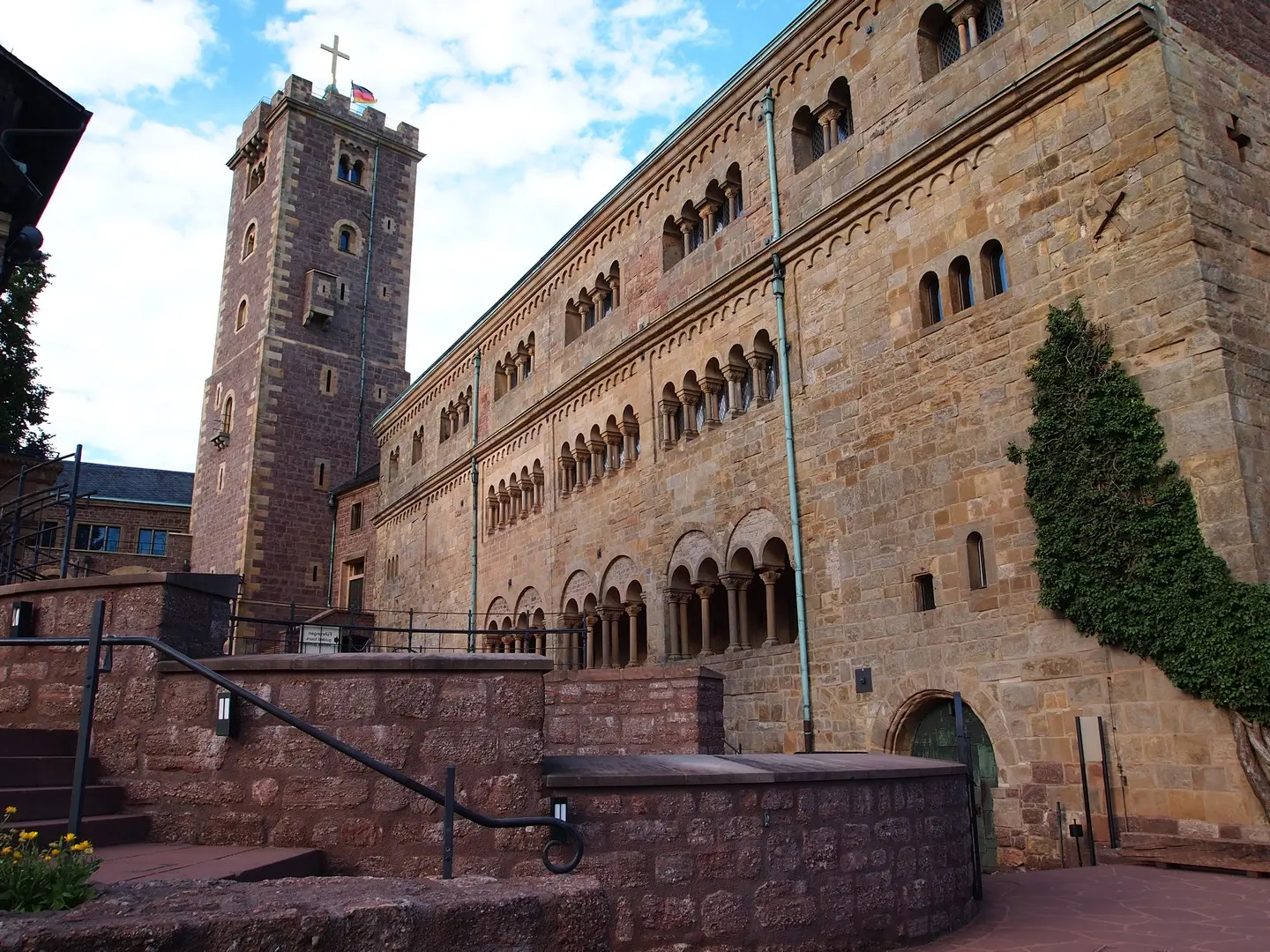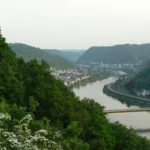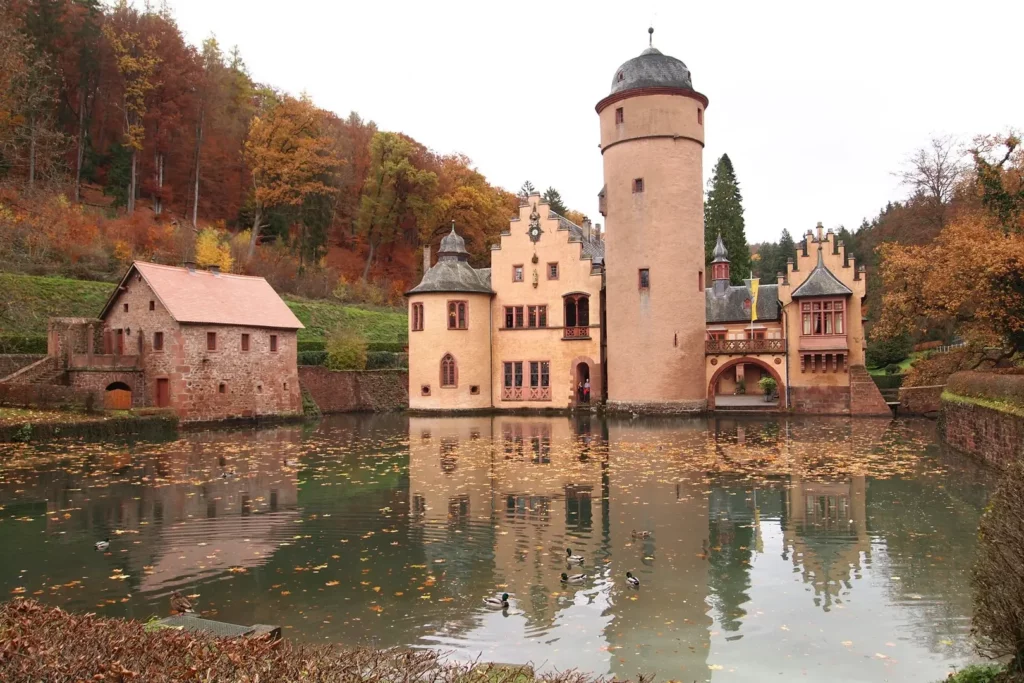Last Updated on 14/05/2023
The Wartburg is a medieval castle, typical on the one hand and rather unusual on the other, since its role in history was determined not by military events, but by cultural ones. Like any self-respecting castle, legends become history there, and legends grow from historical facts.
Since 1999, the castle has been included in the UNESCO list.
Bayreuth. 3. Rock garden Sanspareil
Dresden attractions
What to see in Saxon Switzerland and Osterzgebirge. Maps
Harz map. Center and East – from Wernigerode to Tilleda
I would like to draw your attention to the fact that the castle can only be viewed with a guided tour. And these excursions are not held very often. For those who do not understand German, the guide gives out booklets with the text of the tour in the desired language.
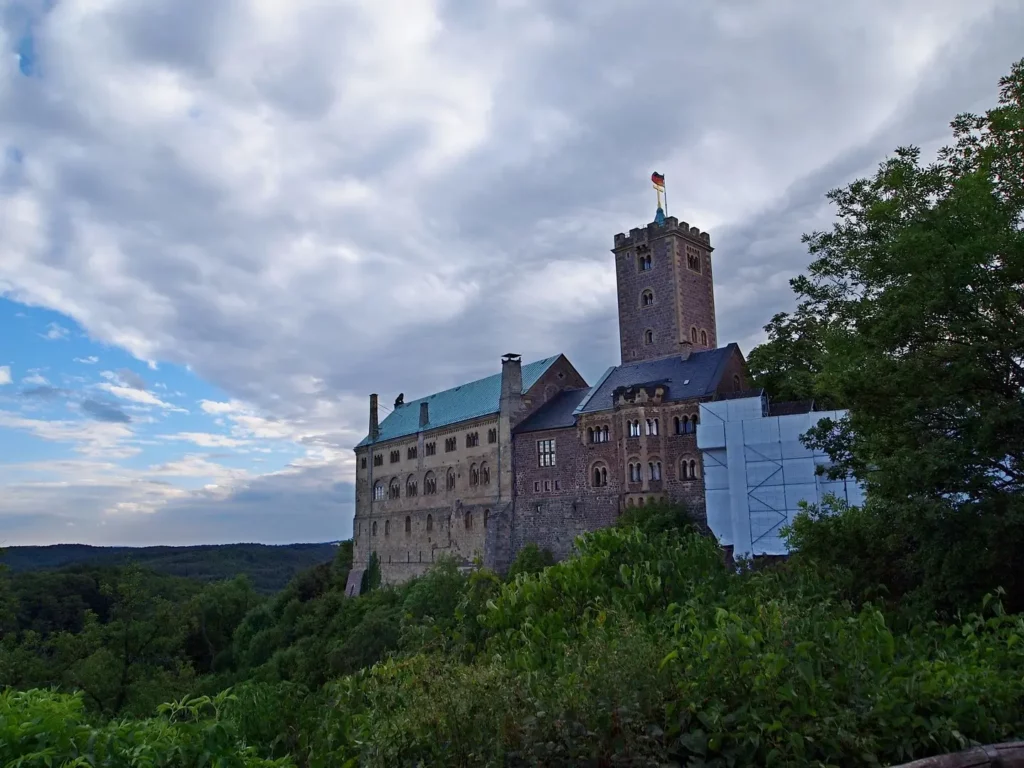
How to get to Wartburg Castle
If you are coming from Erfurt, then leave from the Autobahn at exit 40a (Eisenach Ost) and continue along the B84 until the turn of the road to Wartburg. If you go on the Autobahn from the other side, then, after the exit at Eisenach, it is better to drive along the highway until the intersection with B 84 without entering the city. Or drive further to exit Eisenach Ost. It’s longer but more comfortable.
For those traveling by public transport, there is a combined train + bus (summer season, no. 10) + excursion ticket.
From the city to climb to the Wartburg castle on foot is quite long and steep. Even from the parking lot, you need to climb the stairs in normal mode for 10-15 minutes.
There is a bus to the top. And for children – ascending on donkeys (station at Frankfurterstr. 12, ascending in summer months in good weather, except Mon).
History
Since this is one of the most important German castles, we will tell its history in more detail.
The first mention of the castle dates back to the 1080s, in connection with the war of Henry 4 with the rebellious princes. The founder of the dynasty, Ludwig the Bearded, came to Thuringia from Lower Franconia. It belonged to the count’s family, closely associated with the Archbishopric of Mainz.
The castle was founded, it is believed, by his descendant Ludwig the Springer in 1073 and became the ancestral castle of the Thuringian landgraves of the Ludovings. Before that, apparently, there was a watchtower on the mountain. Warte – hence the name of the castle. The place was strategically important and was located at the intersection of trade routes.
Springer Ludwig was named for the fact that when he was imprisoned for the murder of the Count of Palatine of Saxony and he was threatened with the death penalty, he jumped into the water of the river flowing below. There a servant with a boat was waiting for him. However, this story is more of a legend.
The story of how the castle was founded is most likely the same fiction. According to legend, the mountain on which it was built did not belong to Ludwig. Therefore, he commanded to bring earth from his territory to the mountain, and his loyal knights, standing on the filled earth, swore that they were standing on his land.
For support in the election, the Emperor Lothair 3 gave the son of the Springer, Ludwig 1, in 1131 the title of Landgrave of Thuringia. This title, invented specifically for this occasion, equated the landgrave with the dukes. The next one in the dynasty, Ludwig II, came as close to the imperial family as possible, marrying the sister of Frederick Barbarossa.
The first building was half-timbered, and nothing has survived from it. Ludwig II started a large building in 1156-1162. Under his leadership, the palace was built, which we can admire today. For that time, it was a very unusual and luxurious building. By the way, larger than the imperial palace in Goslar. The eastern part of the wall and part of the gate also date from the 12th century.
The last of the Ludovingians, Henry 4 ruled Thuringia, Hesse and Saxony for 20 years until 1247. After his death (he died childless), the possessions were divided and passed through the female line to the daughters of Elizabeth of Thuringia and Ludwig 4: Hesse to the Dukes of Brabant / Landgrave of Hesse, Saxony and Thuringia to the Meissen dynasty.
Elizabeth is one of the most popular saints in the Middle Ages.
In the 15th century, the Wartburg ceased to be the main residence. At this time, half-timbered buildings were built on its territory. It indicates a change in status – half-timbered houses are cheaper than stone.
In the 16th century, an important event took place in the history of the castle. Here in 1521-1522 Martin Luther was hiding from persecution. In Wartburg, he not only translated the New Testament into German, but also wrote many other works.
The Wartburg managed not to turn into ruins by the end of the 18th century, as happened with many other medieval castles. In 1777, Goethe stayed here for the first time – and was delighted. Later, he offered the Duke to restore the Wartburg and create a museum in it.
Several new buildings were built (mainly in the center of the complex and below (hotel)). The walls of the premises were covered with monumental-historical paintings. A museum exposition has opened in the castle.
After the war, the Wartburg, together with Thuringia, came under the control of the Soviet troops. The museum was opened. But the collection of weapons and armor was removed from it and its traces were lost. In the 1950s, a “de-restoration” was carried out. And some new designs of the 19th century were removed.
Wartburg Castle
Having got acquainted with the history, we will now follow the excursion route.
When we finally reach the top of the hill along the numerous stairs, a gate awaits us. Only from this side can we get to the castle. The gate was built partly in the 12th century and partly in the 14th century.
The gate actually consists of three parts (late Gothic with chains from the drawbridge, oak and a small gate). Then we find ourselves in a courtyard. The buildings to the right of the gate is the Ritterhaus (house of the knights) and Vogtei (house of the steward, vogt). The castle manager and the castle guard lived here. A balcony niche looks clumsy for a reason. It is a late Gothic carved decoration (now a copy), older than the house itself. It was added in the 19th century. The lovely stone tub in front of house is a neo-Gothic addition to the era of historicism.
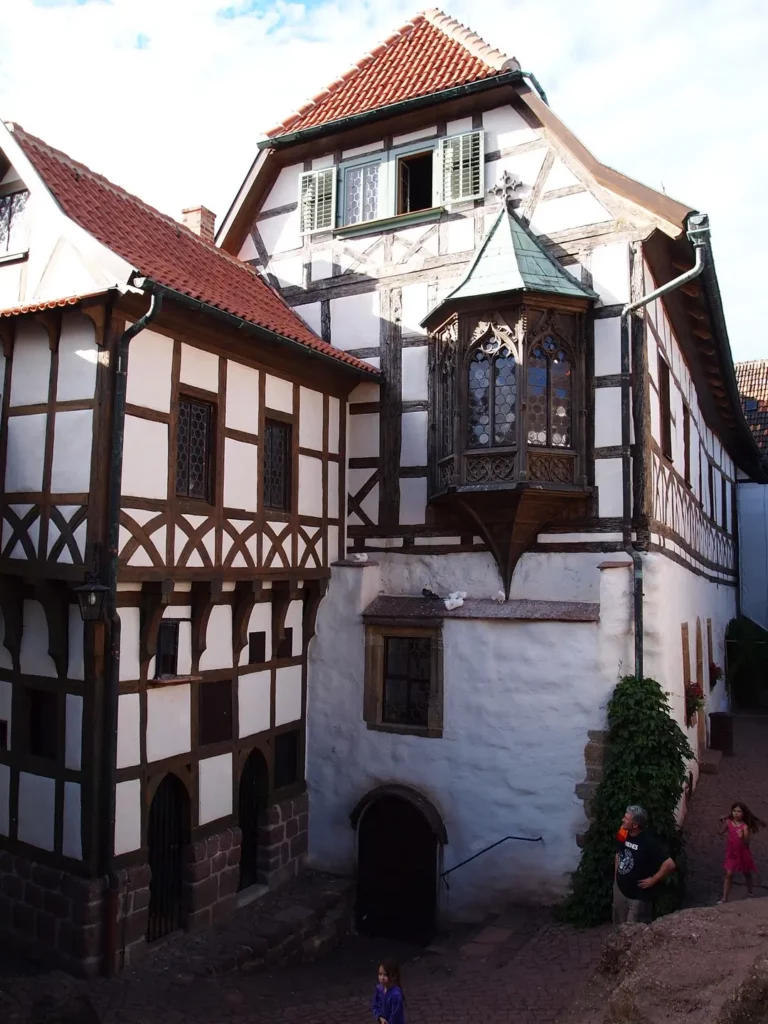
We pass by half-timbered buildings and go straight to the ticket box. This part of the complex is almost modern.
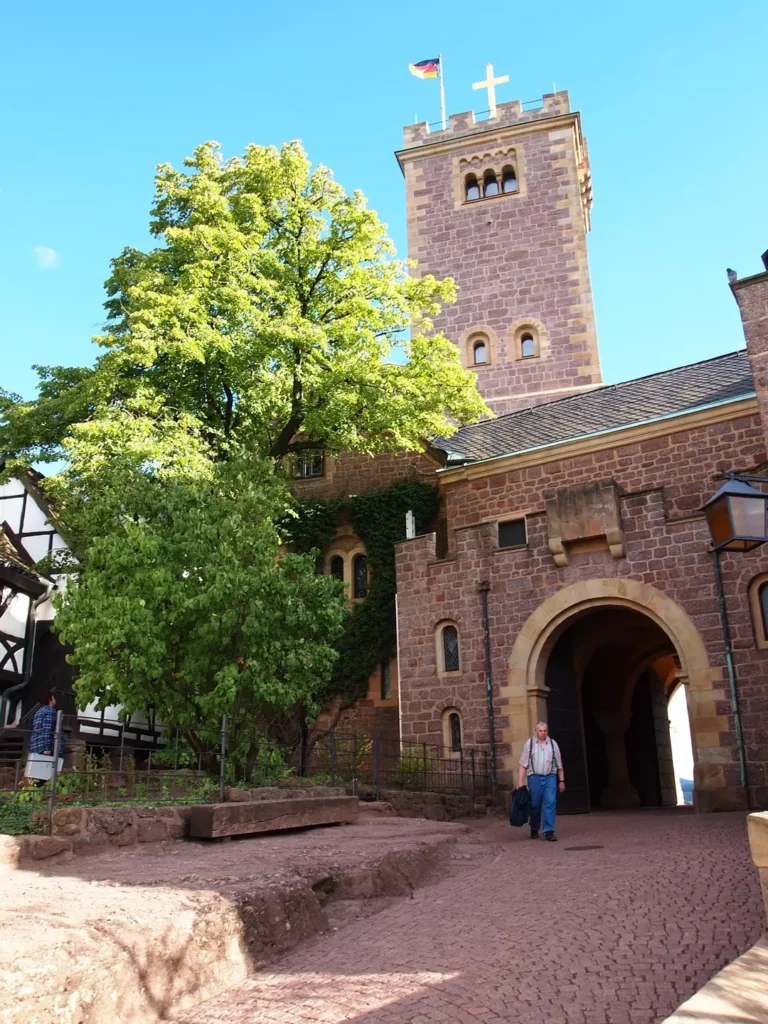
The excursion group gathers in the courtyard at the lower door (follow the signs). This is the oldest part of the complex, “a residential palace with a representative function”. Looking for the door at the very bottom right.
The castle’s columns (there are about 200) and their capitals with different eagles, lions and floral ornaments deserve special attention.
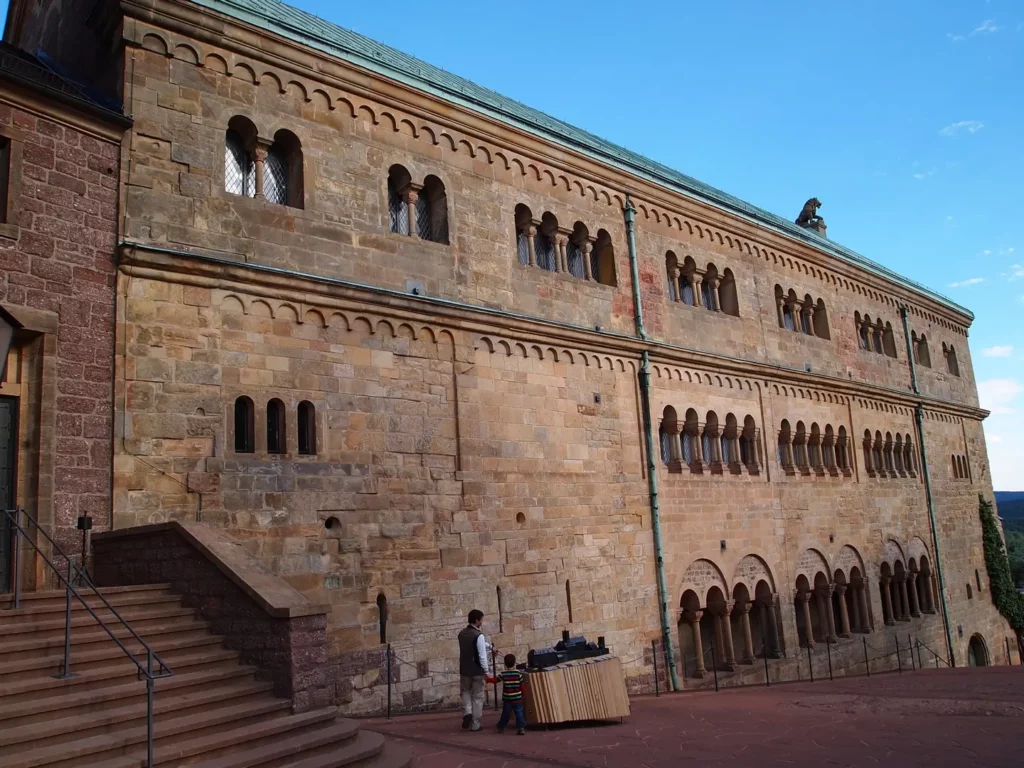
The tour begins in the basement, where various architectural decorative elements are displayed. Restoration work at the end of the 20th century revealed the remains of the heating system, which was carried out from the basement.
First floor
Then we go up to the floor above, to the first floor – there were living rooms here. The first is the Knights’ Hall. Apparently, the Count’s apartments were located here. It is a very small room, with low semicircular vaults resting on a central column.
The next room was probably the dining room. The wooden ceiling of this room dates from the mid-12th century. Original interiors, of course, have not survived. The presented medieval furniture (carpets, cabinets) belongs to the castle’s museum collection, created in the 19th century.
From the dining room you can go to the women’s room, which is mirrored to the men’s room. This is the so-called room of the maiden Elizabeth. The glass mosaic that decorates the room was created in the early 20th century, a gift from Emperor Wilhelm 2. The mosaic depicts scenes from the life of St. Elizabeth.
Saint Elizabeth, daughter of the Hungarian king, was born, according to legend, in 1207, on the day of the famous Minnesinger competition, which I will tell about later. At the age of 4, Hermann 1 took her in Thuringia as future wife of his son. The wedding took place in 1221. This marriage had three children.
The young countess led an ascetic life, according to the principles of St. Francis of Assisi, helped the poor, founded a large hospital for the poor and took care of them herself, giving out generous alms. As a member of the highest nobility and related to the emperor, her husband was supposed to take part in the Crusade, which he did, but died on the way to Italy in 1227. The widow retired to Marburg, where she took a vow of celibacy, continued her charitable work, worked in a hospital and died at the age of 24 in 1231. St. Elizabeth was canonized already 4 years after her death on the basis of evidence of 99 miracles associated with her, and is one of the most popular saints, a symbol of mercy, the patroness of doctors.
Second floor
We rise to the second floor. The first room here is the chapel. Initially, it seems to have existed separately, but burned down. Therefore, from the beginning of the 14th century the chapel was made in the castle itself. “Restorers” of the 19th century slightly changed the appearance of the chapel, murals were created, but during the “de-restoration” these murals were removed. Therefore, now you can see the faint remnants of medieval frescoes.
The next hall is called the Singing Hall. According to the decoration of the columns, it is dated to the second half of the 13th century. These two columns are the only ones that have survived from the previous appearance of the hall. In the 19th centurу it was covered with paintings, the main painting was created by Maurice von Schwind, one of the most prominent artists of the era.
Competitions between minnesingers were common in the 13th century. And the court of Count Herman I, patron of the arts, had a particular influence on the cultural life of Europe. The legend of the Wartburg Competition exists in different versions.
In short, it was like this. Poets and singers were to meet for the competition, including Walter von der Vogelweide, Wolfram von Eschenbach, and Heinrich von Ofterdingen. Probably, even before that, Henry had displeased the count with his audacity. Therefore the death penalty was to be the “reward” for the loser. As expected, the loser was Henry, who dared to sing a laudatory ode not to the count, but to the duke of Vienna. In fear of death, he turned to Countess Sophia, who gave him a pardon for a year. During this year, Heinrich met the Hungarian poet and magician Klingsor, who cunningly brought the conflict to naught.
The legend was reflected in various works of art. The image of Heinrich is often combined with that of another medieval poet, Tannhäuser. Wagner made the Wartburg the scene for his opera Tannhäuser.
In the narrow corridor leading from the chapel along the Singing Hall, also Schwind’s murals. This corridor is called the Elizabeth Gallery, and the frescoes illustrate episodes of her life. The most famous episode is called the miracle of roses. There were two opposing opinions about the character of Elizabeth’s husband. Some sources consider him a rude person, whom only miracles performed by his wife persuaded not to interfere with her. So, he forbade her to feed the beggars. Naturally, she did it in her own way, and once, when Elizabeth was carrying bread to the poor, her husband met her and demanded to show what she was carrying. Elizabeth showed him the roses that the bread had become.
And the last room on this floor is the Landgrave’s room. It is assumed that this room was intended for the conduct of business and meetings. Schwind’s frescoes depict legends from the life of landgraves.
Third floor
Finally, the third floor is occupied by a large hall – Festsaal. After the fire in 1318, a flat ceiling was made in the hall. During the reconstruction of the 19th century it was again changed to a three-piece ceiling that follows the shape of the roof. The rest of the architecture of the hall has remained unchanged. Preserved details that confirm the luxury of the original structure: the columns are made of especially valuable material of that time, the hall was heated by three fireplaces.
The decoration was made by artists of the 19th century. Among the figures of the owners of the castle from different eras there is also the image of the architect who carried out the reconstruction in the 19th century – Hugo von Rittgen. The chairs are arranged in anticipation of the next big concert – various events are regularly held there.
Art collection
As soon as the group admires the hall, they are sent to look at the art collection of the castle. The collection was created in the 19th century. and houses a building also built at this time.
The collection was created partly with donations, partly with funds from the Saxon-Weimar dynasty, which owned the castle. Now there are 9 thousand items in it, but it feels, as much less is exhibited. The most interesting the work of Lucas Cranach the Elder, Madonna and Child with Grapes, 1537
From the museum we go further along the old corridors back to the “front” castle (Vorburg). This corridor goes along the castle wall. Almost nothing can be seen through the window.
Luther’s rooms
Finally, a place of pilgrimage for centuries – Martin Luther’s room at Vogtei. These are the only rooms where the interiors have been preserved.
It was believed that Luther used the stone as a place for ink during his labors, so the pilgrims touched it “for memory” and as a result rubbed a rather large hole in it.
Other buildings
We leave back to the ticket office. Now you can safely examine the castle courtyard.
The big cistern was built in the Middle Ages to filter and collect rainwater from the roof in case of a siege. Opposite the castle there used to be stables, cellars, an arsenal and a brewery. Now there is a 19th century building that served as a hotel.
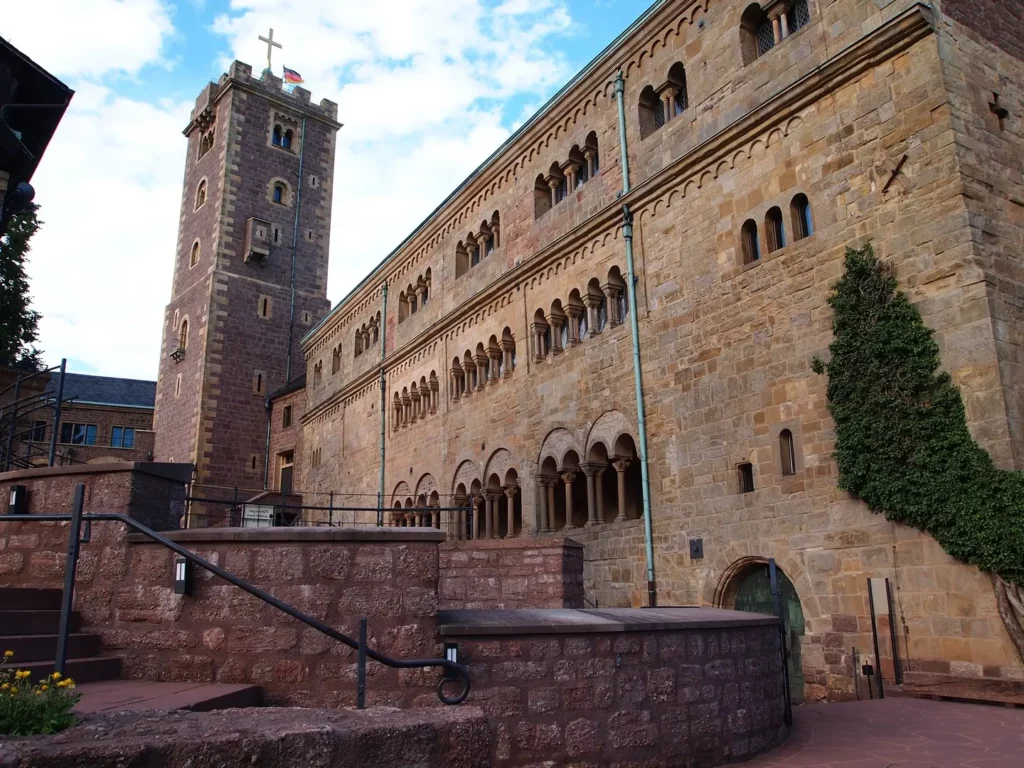
Then we will look into the knight’s bath – a small annex to the palace (19th century). The air and water in the bath is heated, but no one bathes in it. The painting depicts the legendary jump of the castle founder to freedom. (If you do not read what is depicted, then you will not guess – the plot in the picture can be traced very vaguely).
Finally we climb the so-called South Tower. It was built in the 14th century, is 22 meters high and served as a prison. To climb up an external staircase was built in the 19th century. Below there is an automatic machine where you need to throw a small coin. The views are wooded and hilly.
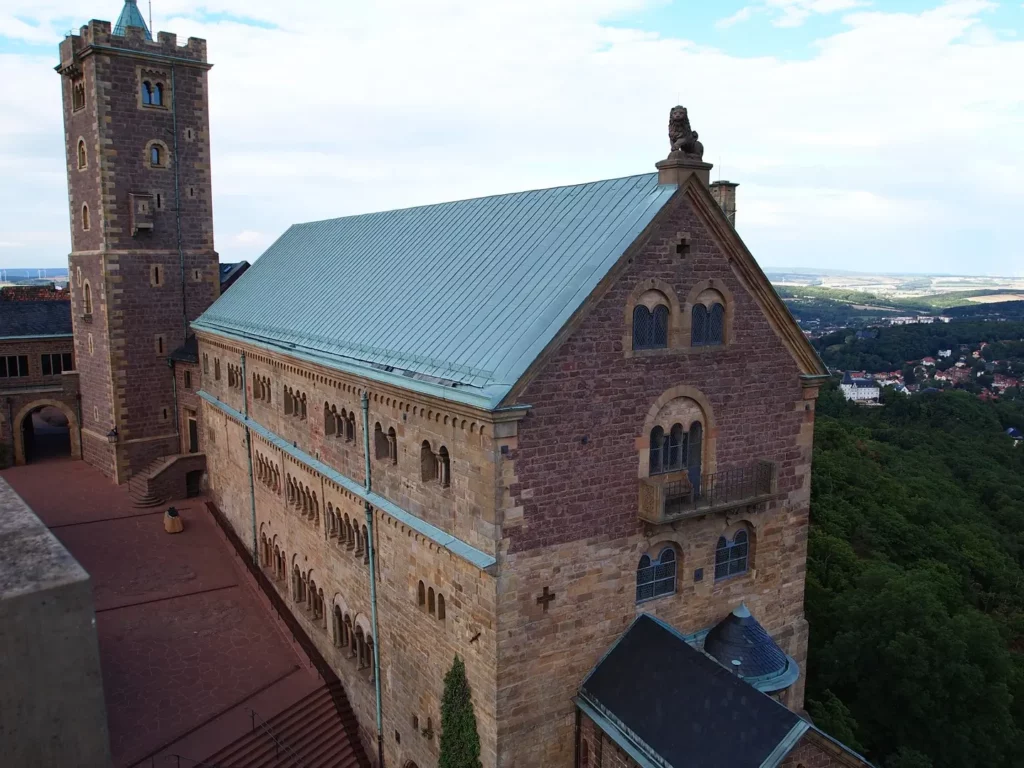

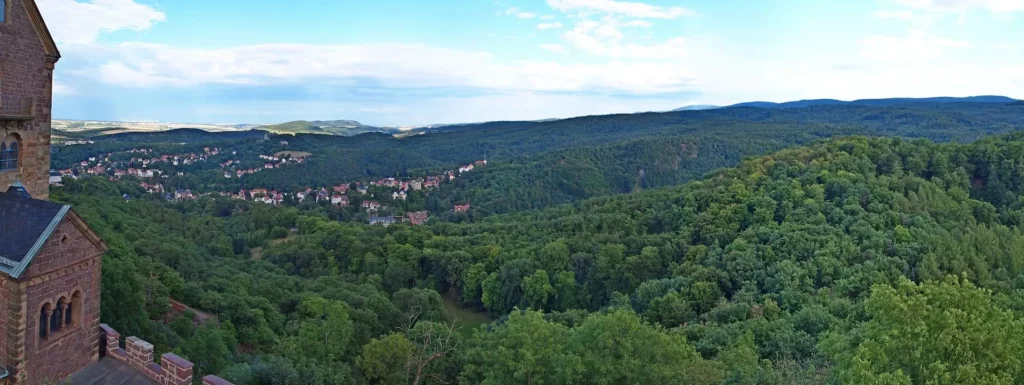
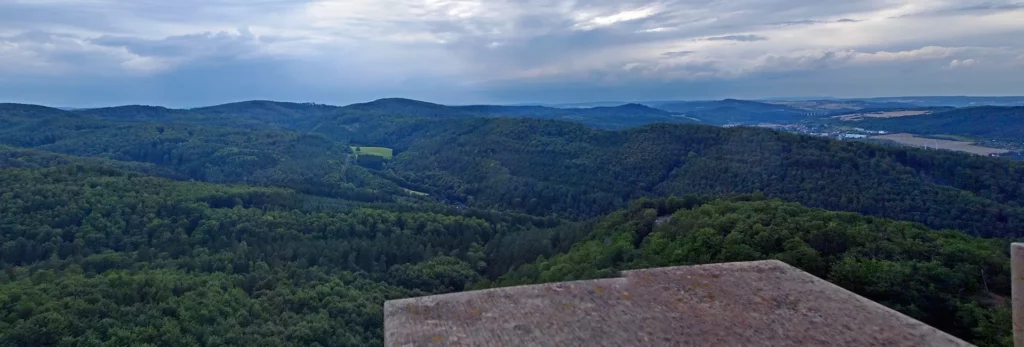
Do you enjoy the site without cookies? This means that I work for you at my own expense.
Perhaps you would like to support my work here.
Or change your cookie settings here. I don’t use personalized ads

